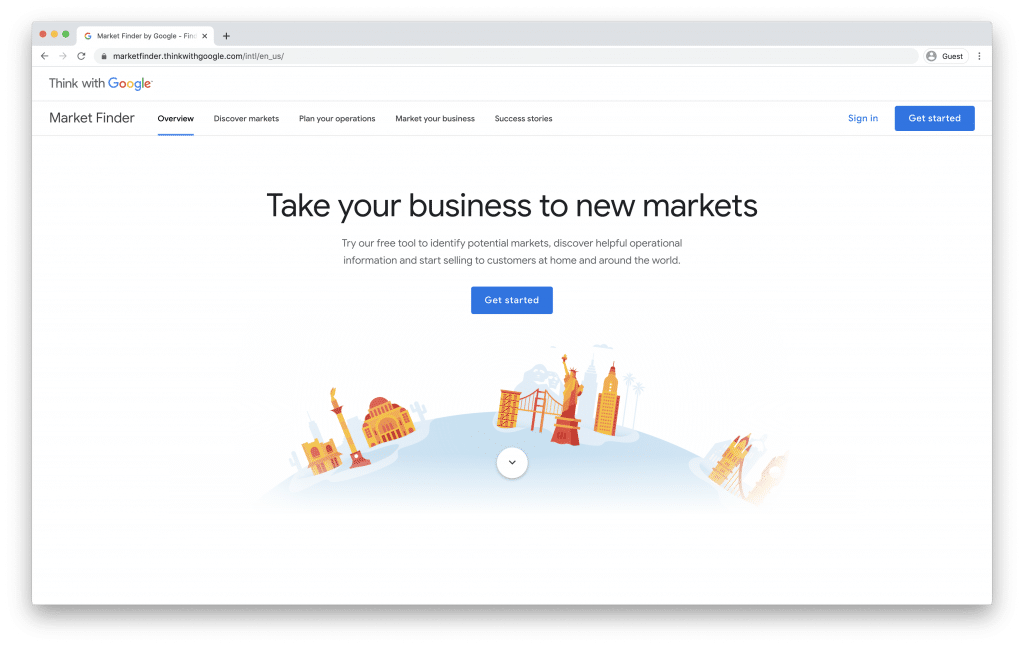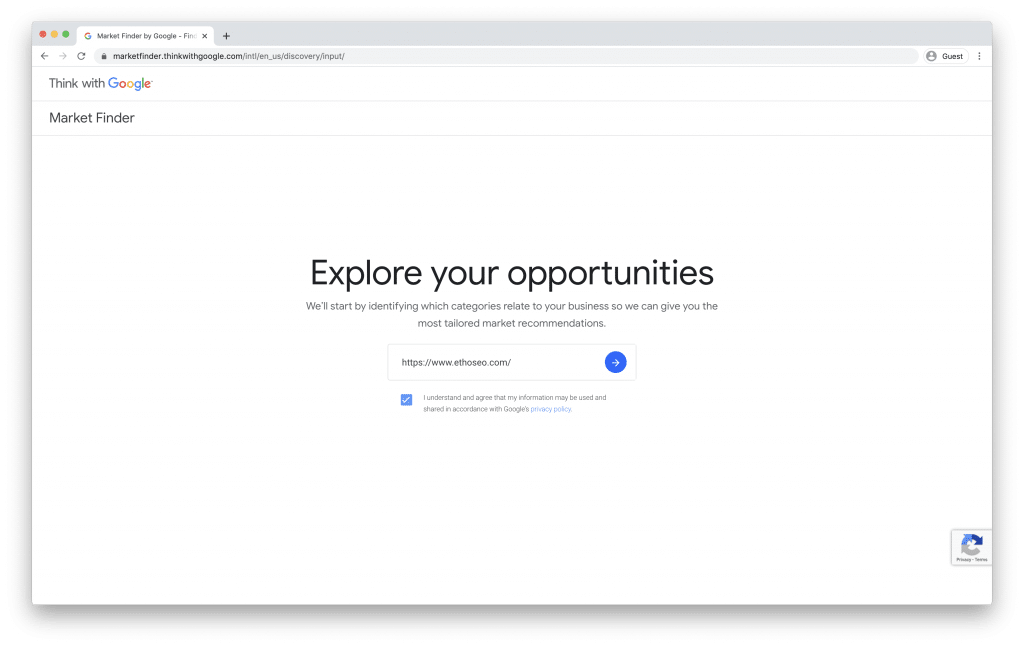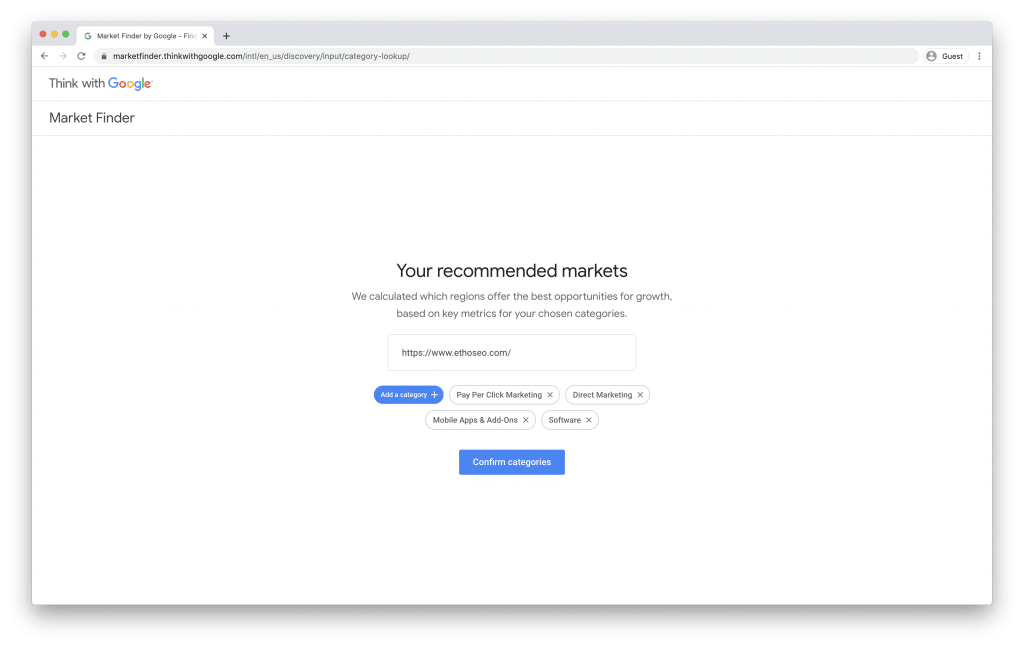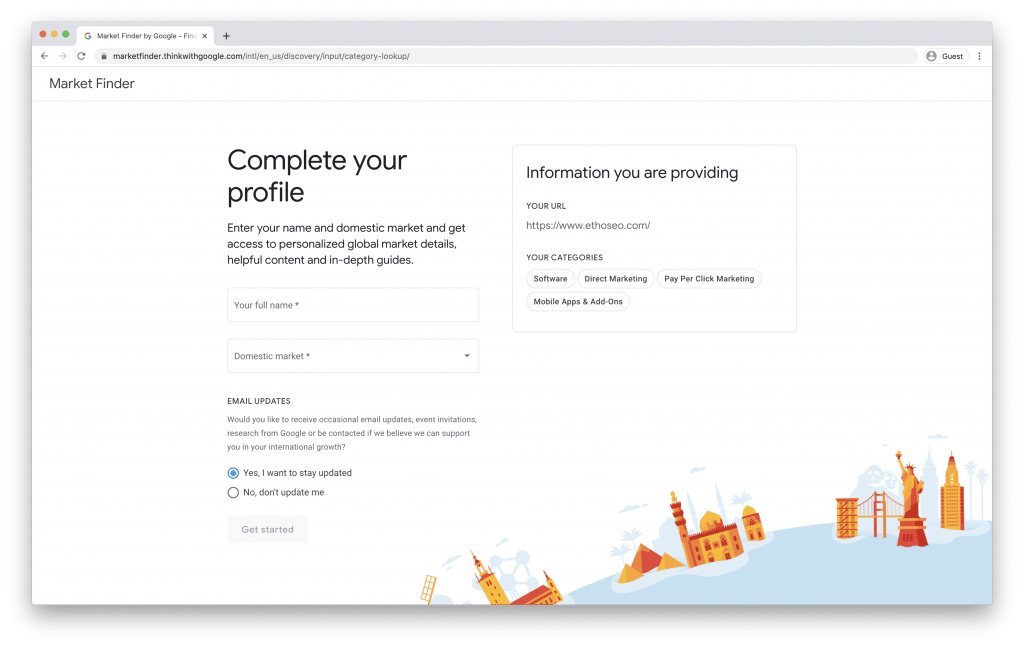Not every business owner thinks about expanding their market share outside of their home country.
That said, if your company sells exclusively to domestic markets, you may be missing out on significant opportunities for growth. The fact is that 95% of global consumers live outside of the U.S.
If you plan to grow your business in 2020 and beyond, it may be worth considering new territories.
But, with 195 countries to choose from, how do you pick an export destination? Google Market Finder is a tool that can help inform your decision.
Market Finder generates a list of geographical locations that may be a good fit for your products and services and provides a wealth of data about those markets.
How Google Market Finder works
Input a URL into Google Market Finder, and it will analyze that website’s products and services. Based on those products, the tool will generate a map of suggested countries for expansion.
For each country, Google Market Finder provides data about search volume, advertising costs, consumer behavior, economic health, ease of doing business, and more.
Top-Level Market Insights
Top-level details that Google Market Finder provides about each market include:
Monthly searches across categories — This metric estimates the number of monthly searches on Google related to your product categories. You can use it as a general indicator of market interest and demand.
Google Ads recommended bid — This metric is the estimated cost-per-click (CPC) on Google Ads for keywords within your product categories. The lower the CPC, the less competition you face.
Ease of doing business — This ranking indicates the relative ease of starting and operating a business in a particular country. The lower the ranking, the easier it is to do business in the country. The top 10 countries for ease of doing business are:
- New Zealand
- Singapore
- Hong Kong
- Denmark
- South Korea (Up significantly from #19 in 2010)
- United States (Down from #4 in 2010)
- Georgia
- United Kingdom
- Norway
- Sweden
Household net disposable income — The amount of money an average household has after taxes are deducted. You can use this information to help determine the purchasing power of consumers within the market.
Top 10 countries with the highest disposable income are:
- United States $46,903
- Switzerland $38,469
- Norway $37,729
- Australia $36,156
- Germany $35,935
- Austria $34,491
- France $32,057
- Belgium $31,971
- Sweden $31,276
- Canada $31,630
Additional Market Insights
In addition to providing you with a top-level snapshot of each market, Market Finder also offers in-depth details about the country’s economy, online behavior, purchase behavior, and cross-border trading logistics.
These details can help inform your decisions about where to focus your expansion efforts and what resources it will take to enter a potential market.
Through Market Finder, you can uncover details about a potential market and its buyers, including:
Economic profile
- Gross domestic product (GDP)
- GDP per capita
- GDP purchasing power per capita
- GDP annual growth
- Household net disposable income
- Unemployment rate
- Global competitiveness
- Logistics performance
Online behavior
- What percentage of a country’s population uses the internet
- What percentage of the population is using high-speed internet
- Android versus iOS usage
- Frequency of viewing online videos on a smartphone
- Frequency of personal internet use
Purchase Behavior
- Frequency of imported purchases
- What percentage of the population is first exposed to a product via online research
- What percentage of the population is first exposed to a product via advertising
- What percentage of the population uses online-only research to find a local business
- What percentage of the population uses search engines to influence their buying decisions
Logistics
- Ease of trading across borders ranking
- The time it takes to comply with a country’s customs regulations (e.g., customs clearance, inspections, handling)
- The cost associated with complying with a country’s customs regulations
- The time it takes to comply with a country’s documentation requirements (e.g., obtaining, processing, and submitting documents).
- Cost to comply with a country’s documentation requirements
You can use the data to better understand a market’s potential and your strategy for entering the market. You’ll know whether consumers are open to ordering foreign goods online, whether they have the disposable income to spend on your products, and whether it’s cost-effective to deal with cross-border trading.
How to get started on Google Market Finder
- Hit the Get Started button on the Google Market Finder website.

- Enter your website’s URL

- Select categories that match your business’ offerings and click Confirm Categories

- View your top market suggestions

- Scroll down to complete your profile. Enter your name, domestic market, and click Get Started.

How you can use Google Market Finder to strengthen your marketing and advertising strategy
Integrated with your existing marketing and advertising strategy, the data you uncover through Google Market Finder can help strengthen your marketing initiatives in a myriad of ways. Here are a couple of examples of how you might use data from the tool to back your strategy:
- Let’s say that you find 20% of consumers in your potential market discover new products via advertising. You also know that Google search volume in the market in your product category is high. Using this information, you can safely conclude that planning an ad campaign on Google makes sense.
- Let’s say you find that only 10% of your new market has access to high-speed internet. You also know that you need to reach users with slower internet connections. With this information, you can determine whether a lightweight website design – and possibly an Accelerated mobile pages (AMP) or a Progressive Web App (PWA) – is worth including in your strategy.
Of course, the data you uncover on Market Finder is only a starting point for your research. You’ll want to cross-reference this information with other market research, as well as analytics and advertising data.
Have you used Google’s Market Finder to explore new markets? Do you plan on expanding into other markets this year? Let us know in the comments below.

